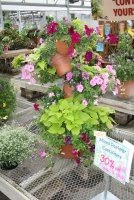If you ever get a chance to hear Ron Rosenberg of
Quality Talk speak on marketing, I really recommend it. It seems a lot of retailers got ideas from his three-session-long talk at Short Course that they'll implement as soon as they get home.
Here are Rosenberg's top 10 marketing strategies to think about:
1. Focus on benefits instead of features.Look at marketing materials and ask yourself So what? The most important real estate in your printed materials is the headline.
2. Look for examples outside your own industry. Don't look at what your competitors are doing and do the same thing. Make your marketing materials about your customers, not about you.
Tip: Get a blue highlighter and a yellow marker. Take your brochures and literature. Anything that's about you, your history or products, highlight in blue. What's about your customer, highlight in yellow. Do you have more blue or yellow?
3. Walk to the edge of the abyss. "The biggest mistake people make in their marketing is it's boring," Rosenberg says. "Peer deep into men's souls. See what keeps them up at night." Find out what motivates people. What will really get people to sit up and take notice?
We sell retreat, the getting away, getting hands dirty, physical rehabilitation. We sell the nice backyard where you can have a barbeque.
"Marketing is not an expense," Rosenberg says. "Done right, it's an investment with an obscenely high rate of return."
4. The Schnauzer EffectOnce you know someone matches your niche, why would you send just one letter? Keep sending.
Rosenberg has received repeated direct mail advertisements for schnauzer themed gift items. How do these companies know he owns a schnauzer? They bought list of owners of schnauzers from vets and license bureaus. How can you make this model work for you?
Tip: Your brochure should not include feature puke, bulleted list of your capabilities. It should explain how your customers benefit from your capabilities. "Our shrubs help you enjoy your outdoor patio.
5. Make decisions based on facts and data.Calculate the value of a lifetime customer of your retail store. Here's Rosenberg's example of himself as an airline customer.
Average plane ticket: 500
Trips per month: 2 = 1,000
Months per year: 10 = $10,000
Number of years: 20 = $200,000 = lifetime customer value
How much does it cost to keep customers over their lifetime, compared to how much they'll spend?
6. Stand out from the pack. Check out LumpyMail.com, which provides send-along items you can mail for promotion. Send your on a letter on a silver platter or send a message in a bottle. It will get attention.
7. The $50 CardFind out how to guarantee that your market will respond to your communications. Have a specific purpose, a killer headline and a clear statement of value.
To get his college-aged kids to call home, Rosenberg filled out a greeting card, and wrote, "In case there's anything you need, here's a $50 gift card." And he didn't include a card. It made them call home for sure.
8. Great marketing examples are everywhereBecome a student of marketing. Watch QVC and the Home Shopping Network. Pick up the National Enquirer. The average price for a full page ad in the Enquirer is $86,400. If an ad is in the National Enquirer over and over, something about that ad is working.
9. Timing Is EverythingBirthday offers can work, but do them right. Don't be cheap. They don't all get redeemed and customers will spend way more than the offer.
10. Take ActionWhy people don't take action?
- Costs too much to implement.
- My business is different.
- I don't know where to start or what to do.

























